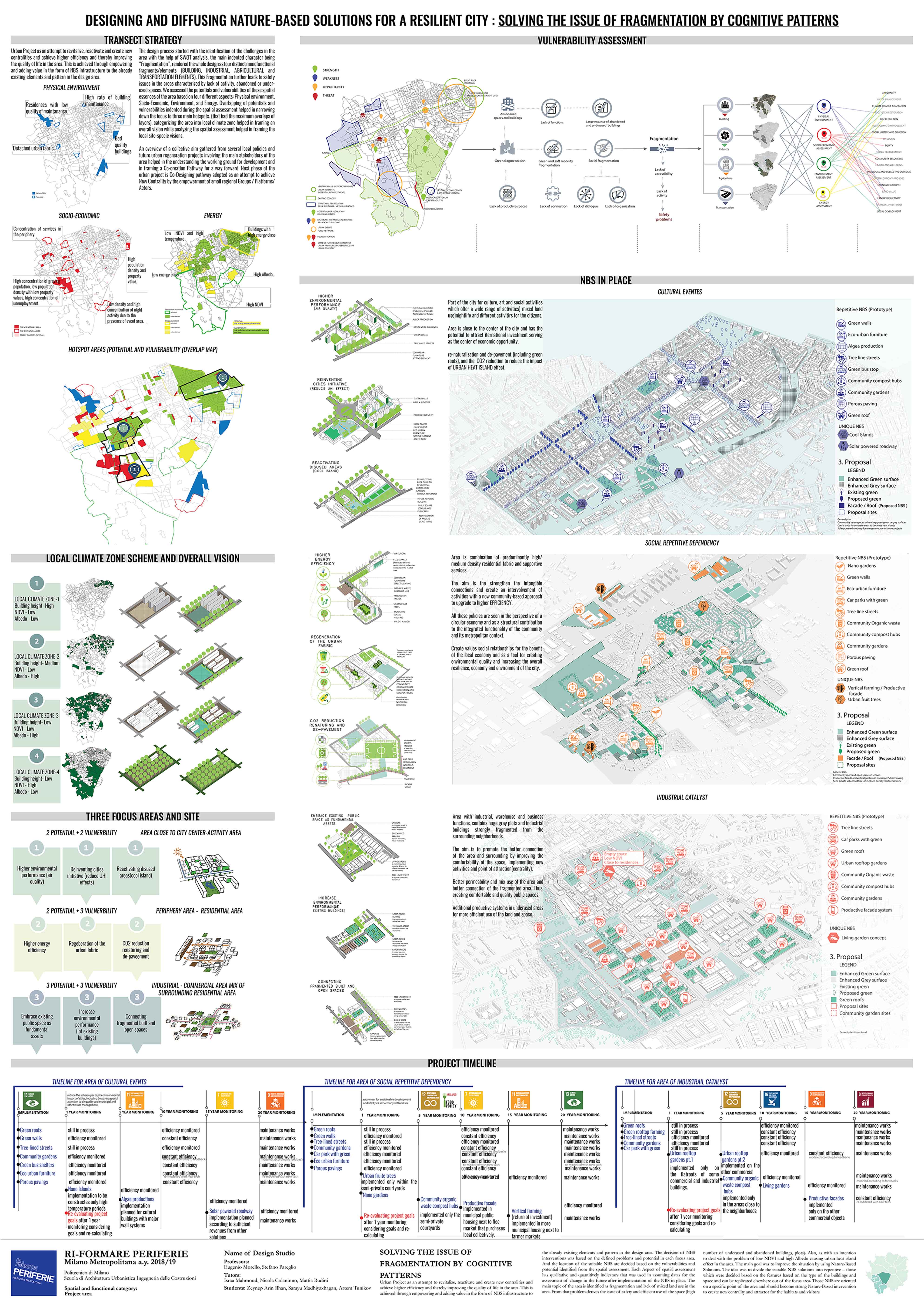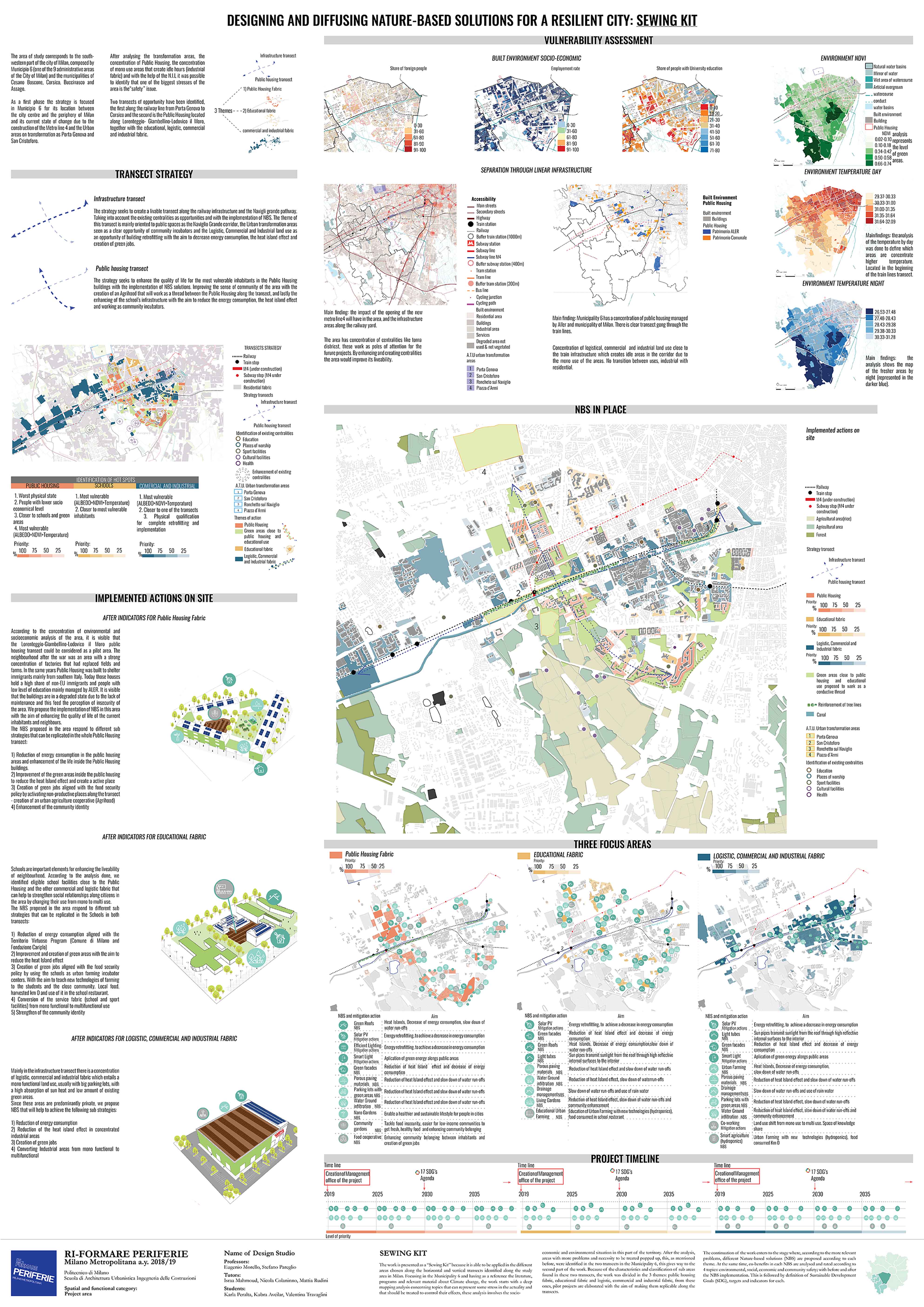Energy and Urban Planning
Eugenio Morello, Stefano Pareglio
ENG/
ADDRESSING A MILANO’S SUSTAINABLE TRANSITION
Addressing a Milano’s sustainable transition means first of all recognising the serious implications of processes like the Climate Change. Addressing the sustainable transition means also recognising that Milano is living a particular moment in which the old socio-economic condition is no longer a valid reference point.
Looking at the city through the lenses of the transition is an useful way to understand possible paths to walk in order to guarantee not only the mitigation and adaptation to Climate Change but also opportunities for co-creation processes.
The focus areas are expression of the transept from the dense city to the countryside of Parco Agricolo sud, a special part of the city where many land-uses coexist. These differences require a specific organic project, able to create new spaces and landscapes that are at the same time rural and urban. The project must also deal with the issues of social segregation and access to opportunities.
Sustainable regeneration is able to address the transition the city is living and the use of the specific tools of the NBS is particularly interesting. These tools are not only able to face the issue of Climate Change in an efficient way, but they are also able to guarantee socio-economic benefits, when properly implemented.
SEWING KIT
After analysing the transformation areas, the concentration of Public Housing, the concentration of mono use areas that create idle hours (industrial fabric) it was possible to identify that one of the biggest stresses of the area is the “safety” issue.
And from this analysis the goal of the main strategy is to create a vibrant, liveable and secure urban area by enhancing social solidarity with the implementation NBS solutions. Two transects of opportunity have been identified, the first along the railway line from Porta Genova to Corsico and the second is the Public Housing located along Lorenteggio- Giambellino-Lodovico il Moro, together with the educational, logistic, commercial and industrial fabric.
ATTACK BOUNDARIES THROUGH A NATURE-BASED BICYCLE NETWORK
The main idea of implementing a nature-based bicycle network was to attack the accessibility risk and the problem also known as the ‘first mile problem’, which is the difficulty in getting people from a starting location to a transportation hub. To avoid the dominance of the car a qualitative alternative for the car are provided for the inhabitants and users of the space. This could strongly improve the air quality and the health and well-being of the people. The nature-based bicycle network is a kind of nature-based solution on its own since it’s part of a green corridor in the city. Besides the transportation linkages, it provides opportunities within recreational objectives, public health, and well-being objectives. It also serves to connect cyclists with nature. But on the other hand, by implementing nature-based solutions on the physical facilities of the bicycle network, a lot of environmental, social and economic risks and challenges could be addressed on top. The choice of the nature-based solutions was led by two main criteria. First of all, the chosen NBS needed to address the determined risks and challenges of the vulnerability assessment. Besides that, the nature-based solutions needed to be implementable on the physical infrastructure of the bicycle network and hence support the functions of a bicycle network.
SOLVING THE ISSUE OF FRAGMENTATION BY COGNITIVE PATTERNS
This project attempts to revitalize, reactivate and create new centralities and achieve higher efficiency and thereby improving the quality of life in the area. This is achieved through empowering and adding value in the form of NBS infrastructure to the already existing elements and pattern in the design area. The design process started with the identification of the challenges in the area with the help of SWOT analysis, the main identified character being “Fragmentation”, rendered the whole design as four distinct monofunctional fragments/elements (BUILDING, INDUSTRIAL, AGRICULTURAL and TRANSPORTATION ELEMENTS). This Fragmentation further leads to safety issues in the areas characterized by lack of activity, abandoned or under-used spaces.
Q.1, B.1, B.2, B.3, S.1, S.2, C.4, A.3, A.4 
Studenti: Tommaso Cigognetti, Zesyl Christine Francisco, Francesco Manea
Studenti: Karla Peralta, Kubra Avcilar, Valentina Travaglini
 Studenti: Sedat Arda, Farzaneh Falakrou, Suzan Vanryckeghem
Studenti: Sedat Arda, Farzaneh Falakrou, Suzan Vanryckeghem
 Studenti: Zeynep Arin Ilhan, Sarayu Madhiyazhagan, Artem Tunikov
Studenti: Zeynep Arin Ilhan, Sarayu Madhiyazhagan, Artem Tunikov
